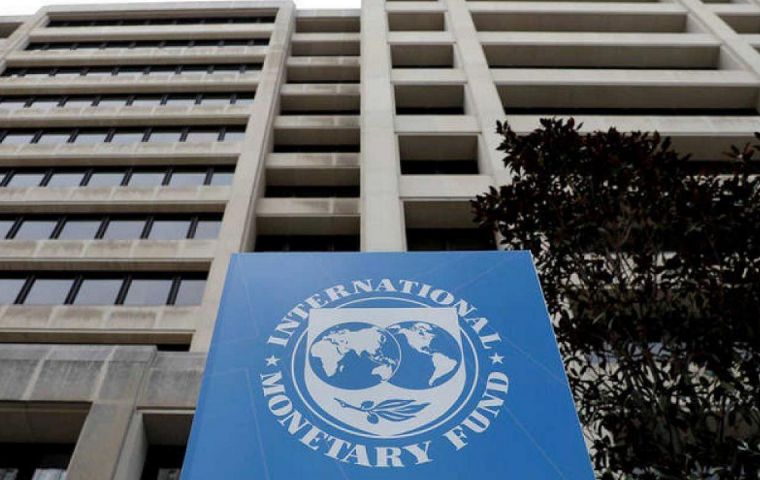MercoPress. South Atlantic News Agency
IMF praises Uruguay's handling of the pandemic and forecasts 3,4% recovery this year
 The country stands out in the region for its well-functioning democracy, strong institutions and high degree of social cohesion
The country stands out in the region for its well-functioning democracy, strong institutions and high degree of social cohesion The IMF elaborated and presented this month a preliminary statement on the situation of the Uruguayan economy based on Article IV mission findings.
Missions are undertaken as part of regular (usually annual) consultations under Article IV of IMF's Articles of Agreement, in the context of a request to use IMF resources (borrow from the IMF), as part of discussions of staff monitored programs, or as part of other staff monitoring of economic developments.
The report begins stating that Uruguay entered the pandemic with solid institutions but pre-existing macroeconomic imbalances. The country stands out in the region for its well-functioning democracy, strong institutions and high degree of social cohesion. Its solid financial sector, ample reserve buffers and investment grade status are key pillars of its stable economy. However, the economy had been on a stagnant path since 2015—after the end of the last commodity price boom—amid low investment and a weak manufacturing sector, which contributed to a secular fall in employment.
Poor education outcomes contributed to an erosion of human capital and high and persistent youth unemployment. Public finances had also weakened markedly in the years preceding the pandemic—leading to a 10% of GDP increase in non-financial public sector debt between 2013 and 2019. The new administration took over in early 2020—only weeks before the pandemic—and launched an ambitious program of reforms to boost growth and strengthen public finances, notwithstanding the challenging circumstances.
The economy contracted markedly in 2020, albeit less than other countries in the region. As the pandemic struck, like in the rest of the world, activity fell sharply in the second quarter of 2020—reflecting social distancing measures and the sudden drop in mobility—before rebounding in subsequent quarters to end the year with a 5.9% decline in output. Contact-intensive sectors bore the brunt of the fall as demand dropped sharply. Employment followed the contraction and rebound in economic activity, with higher impact on young and low-earning workers, contributing to an increase in poverty, although from a relatively low base. The contraction in employment and economic activity, as well as the widening of the fiscal deficit, were less pronounced than in other countries in the region.
A well-targeted policy response
A very effective policy response mitigated the impact of the pandemic while prudently balancing fiscal sustainability objectives. The strong existing health care and social protection systems, along with low poverty rates limited the need for additional fiscal resources to directly address the health crisis. A fiscal package of about 2.7 percent of GDP for 2020-21—commensurate with available policy space—provided well-targeted support to firms, employment and the most vulnerable. The introduction of the partial unemployment benefit was instrumental to containing employment losses and supporting the jobs recovery—by maintaining employer-employee relationships—while increased transfers through the strengthening of existing social programs and the creation of new ones provided needed support to the most vulnerable groups. A prudent wage policy—balancing workers’ purchasing power and the need to support employment—was also key to support the labor market. At the same time, it is worth noting the creation of the Covid-19 Solidarity Fund to separately record temporary measures to contain the impact of the pandemic. A new fiscal framework—aimed at strengthening fiscal discipline and ensuring medium-term sustainability—served to strongly signal the authorities’ commitment with fiscal sustainability.
Monetary loosening, along regulatory forbearance and credit guarantee lines helped sustain companies and prevent financial stress. The BCU loosened monetary policy in response to the pandemic to provide liquidity and avoid disruptions in the money market. At the same time, the BCU clearly signaled a renewed commitment to bringing down inflation, including through changes to its monetary policy framework and the return to the interest rate as operational instrument. Regulatory forbearance—especially the extension of bank loan repayments—and credit guarantee lines at favorable terms for small and medium-size enterprises through the National System of Guarantees (SIGA) were also key to maintaining companies afloat and avoid financial stress.
The ongoing recovery
The recovery in early 2021 was uneven, reflecting a late but strong COVID wave. Supported by policy measures, the increase in mobility, and robust external demand and export prices, primary activities and construction recovered strongly, and activity in those sectors reached pre-pandemic levels. Contact-intensive sectors, on the other hand, remained subdued, reflecting the strong COVID wave in early 2021. After rebounding in 2020, about 50 percent of the losses in employment have already been recovered.
The economy is expected to continue strengthening in late 2021 and 2022. Thanks to the rapid vaccination campaign—about 77% of people are fully vaccinated—the spread of the virus has come to a near halt, the economy is reopening and there are signs of recovery in lagging sectors. Driven by normalizing contact-intensive sectors, the recovery in economic activity and employment are expected to gain strength in the coming quarters. The economy is projected to grow by 3.4% in 2021 and 3.2% in 2022. A reopening of borders and the associated resumption of tourism may provide further support to growth in 2022, although prospects remain uncertain. Inflation is projected to end 2021 around 7.2%, to continue on its downward path to reach 5.8% by end-2022.




Top Comments
Disclaimer & comment rulesCommenting for this story is now closed.
If you have a Facebook account, become a fan and comment on our Facebook Page!